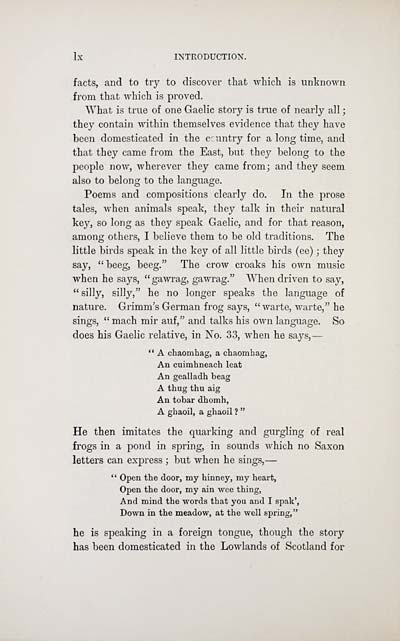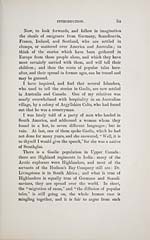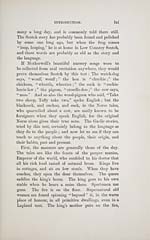Download files
Complete book:
Individual page:
Thumbnail gallery: Grid view | List view

Ix INTRODUCTION.
facts, and to try to discover that which is unknoM'n
from that which is proved.
What is true of one Gaelic story is true of nearly all ;
they contain within themselves evidence that they have
been domesticated in the c^ untry for a long time, and
that they came from the East, but they belong to the
people now, wherever they came from; and they seem
also to belong to the language.
Poems and compositions clearly do. In the j)rose
tales, when animals speak, they talk in their natural
key, so long as they speak Gaelic, and for that reason,
among others, I believe them to be old traditions. The
little birds speak in the key of all little birds (ee) ; they
say, "beeg, beeg." The crow croaks his own music
when he says, "gawrag, gawrag." When driven to say,
"silly, silly," he no longer speaks the language of
nature. Grimm's German frog says, "warte, warte," he
sings, " mach mir auf," and talks his own language. So
does his Gaelic relative, in No. 33, when he says, —
" A chaomhag, a chaomhag,
An cuimhneach leat
An gealladh beag
A thug thu aig
An tobar dhomh,
A ghaoil, a ghaoil ? "
He then imitates the quarking and gurgling of real
frogs in a jDond in spring, in sounds which no Saxon
letters can express ; but when he sings, —
" Open the door, my hinney, my heart,
Open the door, my ain wee thing,
And mind the words that you and I spak',
Down in the meadow, at the well spring,"
he is speaking in a foreign tongue, though the story
has been domesticated in the Lowlands of Scotland for
facts, and to try to discover that which is unknoM'n
from that which is proved.
What is true of one Gaelic story is true of nearly all ;
they contain within themselves evidence that they have
been domesticated in the c^ untry for a long time, and
that they came from the East, but they belong to the
people now, wherever they came from; and they seem
also to belong to the language.
Poems and compositions clearly do. In the j)rose
tales, when animals speak, they talk in their natural
key, so long as they speak Gaelic, and for that reason,
among others, I believe them to be old traditions. The
little birds speak in the key of all little birds (ee) ; they
say, "beeg, beeg." The crow croaks his own music
when he says, "gawrag, gawrag." When driven to say,
"silly, silly," he no longer speaks the language of
nature. Grimm's German frog says, "warte, warte," he
sings, " mach mir auf," and talks his own language. So
does his Gaelic relative, in No. 33, when he says, —
" A chaomhag, a chaomhag,
An cuimhneach leat
An gealladh beag
A thug thu aig
An tobar dhomh,
A ghaoil, a ghaoil ? "
He then imitates the quarking and gurgling of real
frogs in a jDond in spring, in sounds which no Saxon
letters can express ; but when he sings, —
" Open the door, my hinney, my heart,
Open the door, my ain wee thing,
And mind the words that you and I spak',
Down in the meadow, at the well spring,"
he is speaking in a foreign tongue, though the story
has been domesticated in the Lowlands of Scotland for
Set display mode to: Large image | Transcription
Images and transcriptions on this page, including medium image downloads, may be used under the Creative Commons Attribution 4.0 International Licence unless otherwise stated. ![]()
| Early Gaelic Book Collections > Matheson Collection > Popular tales of the west Highlands > Volume 1 > (80) |
|---|
| Permanent URL | https://digital.nls.uk/81388188 |
|---|
| Description | Volume I. |
|---|---|
| Shelfmark | Mat.74 |
| Additional NLS resources: | |
| Attribution and copyright: |
|
| Description | Items from a collection of 170 volumes relating to Gaelic matters. Mainly philological works in the Celtic and some non-Celtic languages. Some books extensively annotated by Angus Matheson, the first Professor of Celtic at Glasgow University. |
|---|
| Description | Selected items from five 'Special and Named Printed Collections'. Includes books in Gaelic and other Celtic languages, works about the Gaels, their languages, literature, culture and history. |
|---|

